33 Common Backyard Birds in Maryland (with Pictures)
Last Updated on
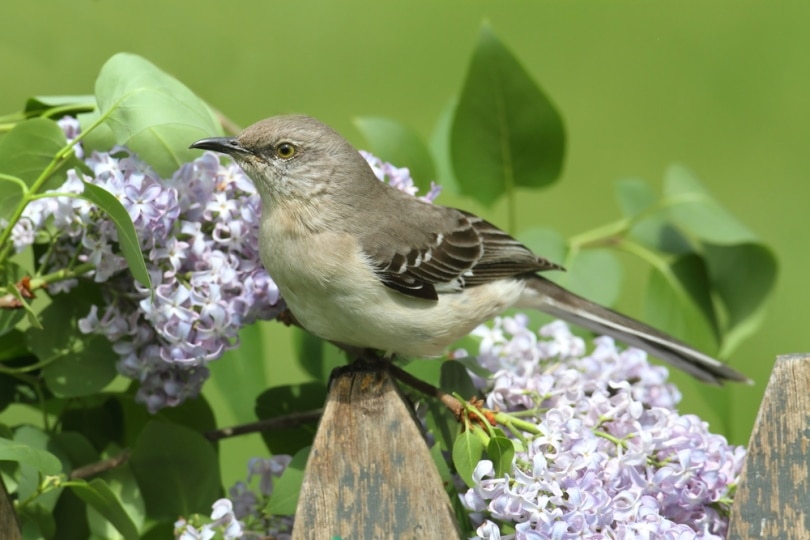
The state of Maryland is home to a wide variety of airborne creatures, and many of them can be seen right behind your house. Depending on where you live, some may be more common than others. Below is a list of 33 common backyard birds in Maryland and what makes them special. Save this page and come back to it once you’ve found a Maryland songbird or bird of prey that you think is interesting—maybe you will learn more about them!
The 33 Most Common Backyard Birds in Maryland
1. American Robin
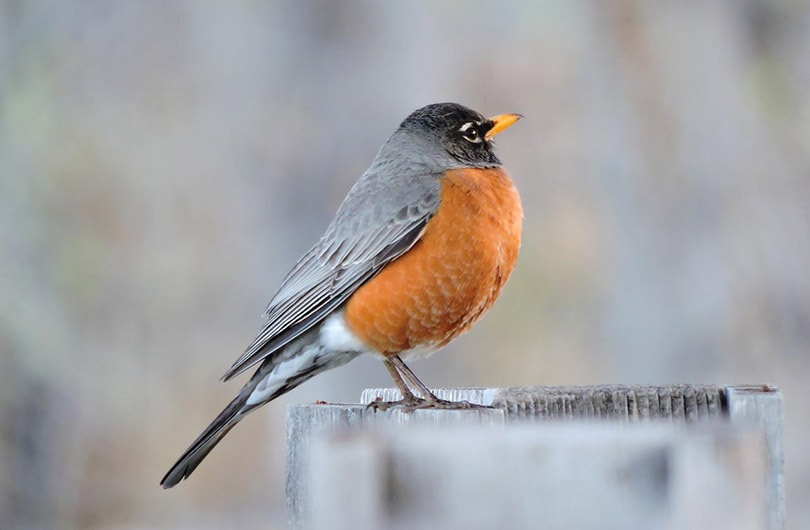
| Scientific name: | Turdus migratorius |
| Family: | Turdidae |
| Endangerment: | Stable |
The classic American Robin is known as one of the most popular small birds in North America and resides in Maryland in both urban and rural environments year-round. They are omnivorous and enjoy feeding on sunflower seeds, various fruits, and worms.
Generally, their distinct orange belly contrasted with the rest of their black and gray body is an easy identification feature. Songs of the robin are also recognizable, as they chirp in an uplifting fashion. This is especially the case for males.
2. American Crow

| Scientific name: | Corvus brachyrhynchos |
| Family: | Corvidae |
| Endangerment: | Stable |
Contrary to many of the other birds on this list, the American Crow has a singular black coat and can be found almost anywhere in the country through a variety of living areas. They mostly scavenge off dead animal carcasses or food scraps.
Some mistake the crow for the raven because of their similar color scheme. However, American Crows are much smaller and don’t have the same size beak.
3. Black-Capped Chickadee
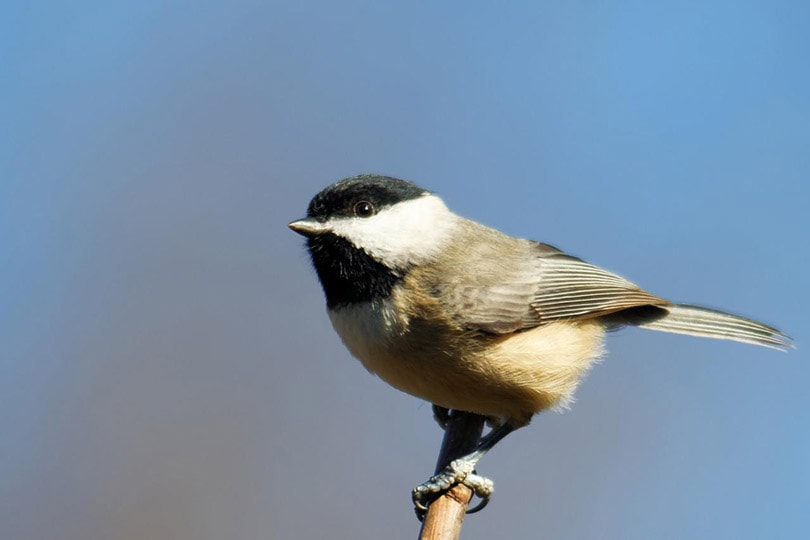
| Scientific name: | Poecile atricapilluss |
| Family: | Paridae |
| Endangerment: | Stable |
One of the most adorable birds you can see throughout the western part of Maryland is the Black-Capped Chickadee. They live here year-round, feeding on insects that crawl upon leaves in forests.
This species is also famous for its “chickadee-dee-dee” song when they feel endangered. Using a birdfeeder will likely attract them to your backyard since they’re reasonably tame around humans.
4. Northern Cardinal
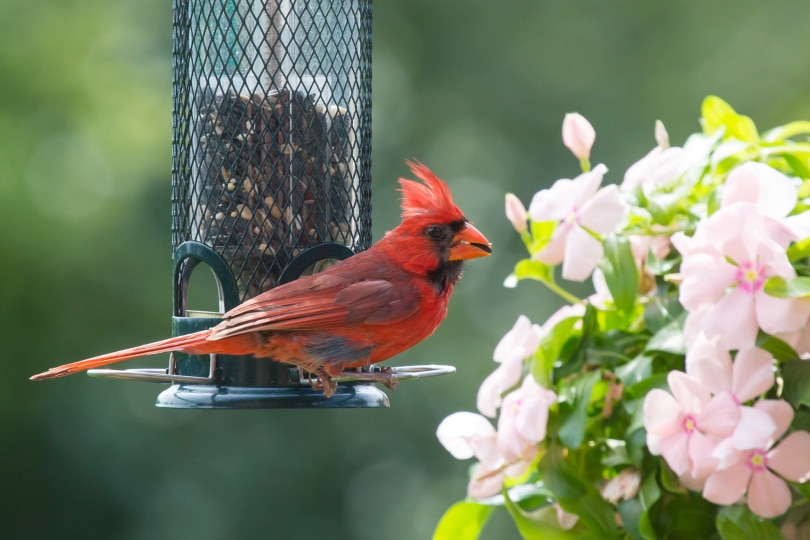
| Scientific name: | Cardinalis cardinalis |
| Family: | Cardinalidae |
| Endangerment: | Stable |
The saturated, popping shades of red that Northern Cardinals exhibit is the kind that draws utmost attention among birdwatchers. Males have especially bold colors and have a consistent hue along with their bodies.
On the other hand, the females have only partially red areas and are otherwise a shade of yellow or brown. They feed on seeds while searching the forest floor and hide in bushes.
5. American Goldfinch
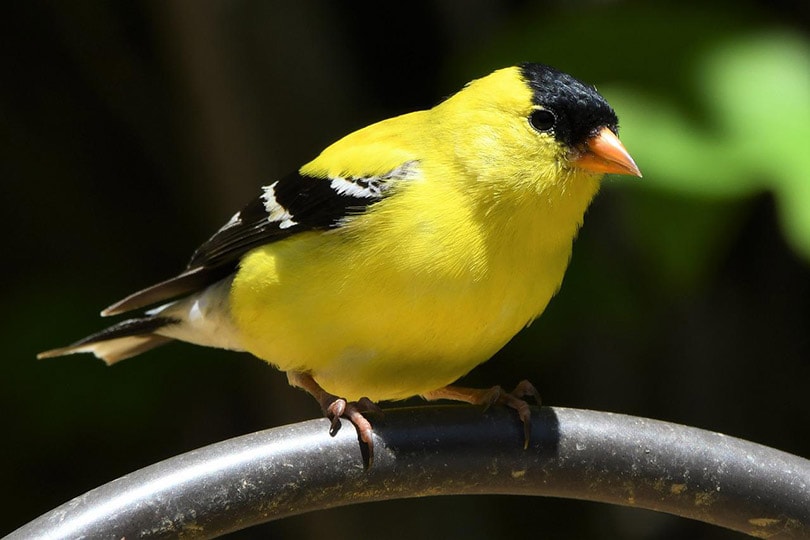
| Scientific name: | Spinus tristus |
| Family: | Fringillidae |
| Endangerment: | Stable |
Similar to the Northern Cardinal, the American Goldfinch has striking colors, especially in breeding males. You can find them year-round in any part of Maryland. They love seeds, so attracting them should be fairly easy. In the woodlands, they do enjoy picking at leaves or branches to find small bugs that are feeding on greens.
6. Blue Jay
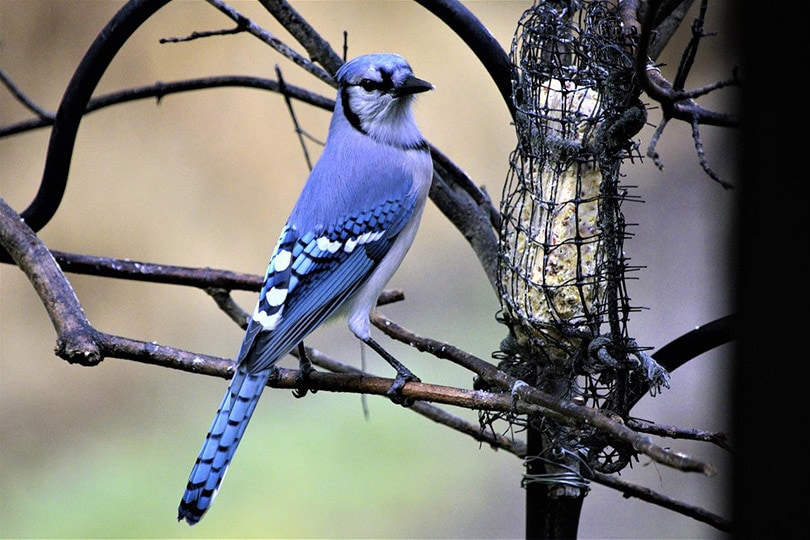
| Scientific name: | Cyanocitta cristata |
| Family: | Corvidae |
| Endangerment: | Stable |
Many people may not know this, but the Blue Jay is related to the American Crow. However, they generally are sought after for their beautiful blue tones and bright chirps. They’re a considerable size, though, so if you do have a feeder, make sure it’s sturdy enough.
Blue Jays can be found anywhere in the state during all seasons, and you’ll likely encounter them on forest trails foraging for food on the ground.
7. Downy Woodpecker
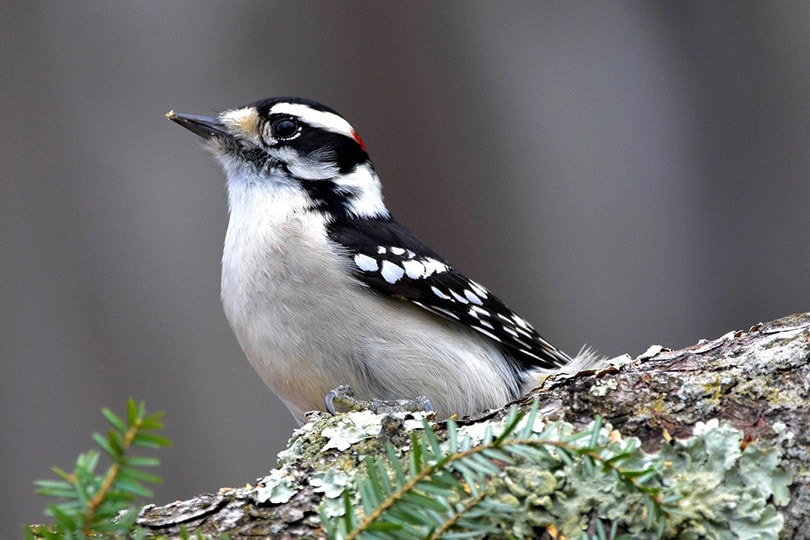
| Scientific name: | Dryobates pubescens |
| Family: | Picidae |
| Endangerment: | Stable |
As common woodpeckers across the United States, Downy Woodpeckers are known for their persistence in making their homes inside of trees or wooden objects so they can protect their young. It’s unlikely that they will come to your feeder unless you put some worms in there, as they’re more drawn to insects. Watch out, though, because they have been found to build their nests on the sides of residential homes.
8. Baltimore Oriole

| Scientific name: | Icterus galbula |
| Family: | Icteridae |
| Endangerment: | Stable |
With a name that matches one of Maryland’s premier cities, the Baltimore Orioles are exceptionally unique with their orange and black colors. In this state, they breed and migrate to the south during winter. While they live here, they’re enticed by fruits or insects that can be found while foraging the forest branches.
9. Red-Bellied Woodpecker
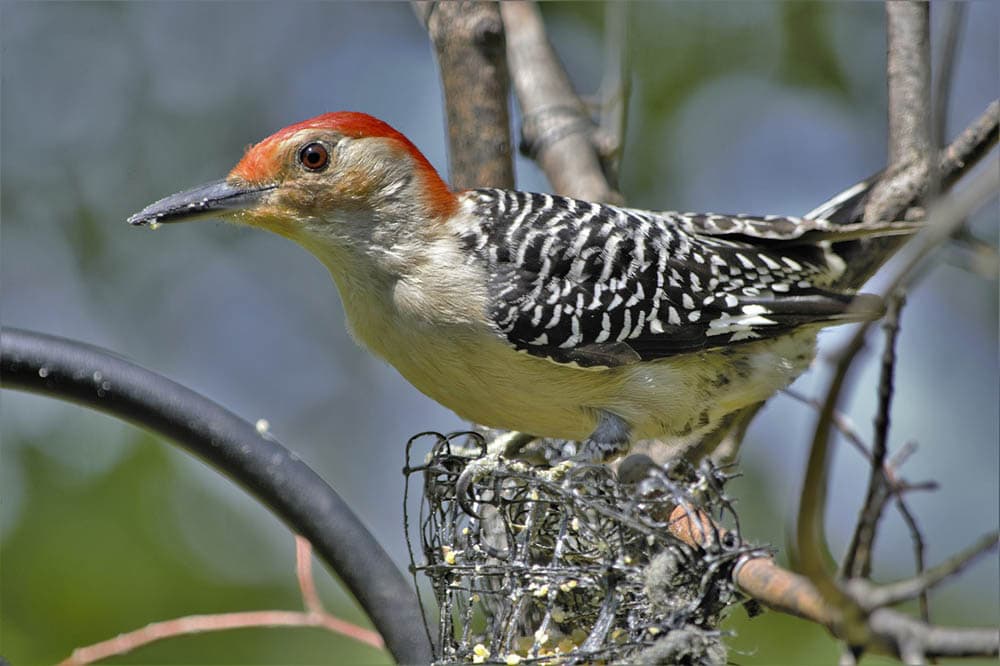
| Scientific name: | Melanerpes carolinus |
| Family: | Picidae |
| Endangerment: | Stable |
This species of woodpecker has a visible contour across its head that displays deep reds, oranges and pinks. The Red-Bellied Woodpecker can be found all around Maryland and can be heard making thudding or knocking noises while drilling away to make a cavity for their eggs. As most woodpeckers do, they primarily eat insects.
10. House Finch
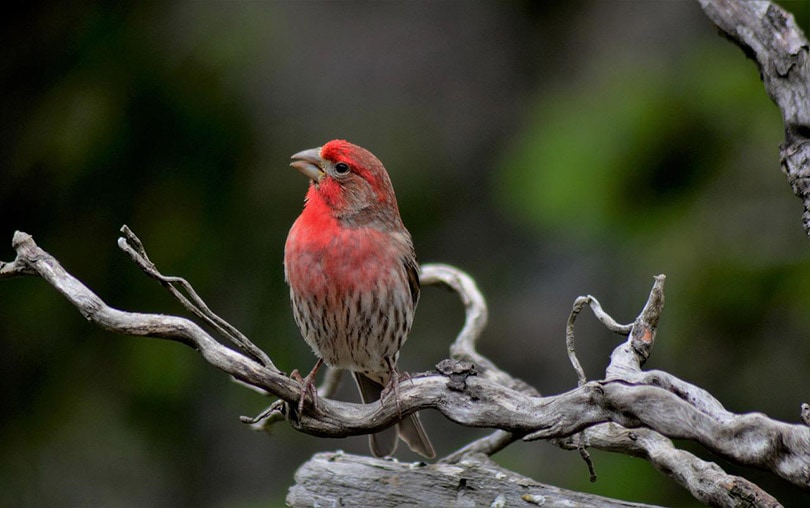
| Scientific name: | Haemorhous mexicanus |
| Family: | Fringillidae |
| Endangerment: | Stable |
As its name suggests, these birds live in residential areas with a lot of people around. Luckily, that makes it a whole lot easier to attract them to your home, and they’ll be quite content with basic birdseed. They can sometimes come in flocks, too, so you may have more company even if you only see a single one. Males have a distinct red color on their upper portion, whereas females look like typical brown birds in Maryland.
11. White-Breasted Nuthatch

| Scientific name: | Sitta carolinensis |
| Family: | Sittidae |
| Endangerment: | Stable |
This species of bird is a common sight across the nation, living through winters and into the spring. In Maryland, you shouldn’t have any trouble finding them since they’re found pretty much everywhere and feed on insects, seeds, and nuts that they can finagle into tight spaces to store for later. The females tend to move downwards on tree trunks and have a lighter color on the top of their heads.
12. Common Grackle
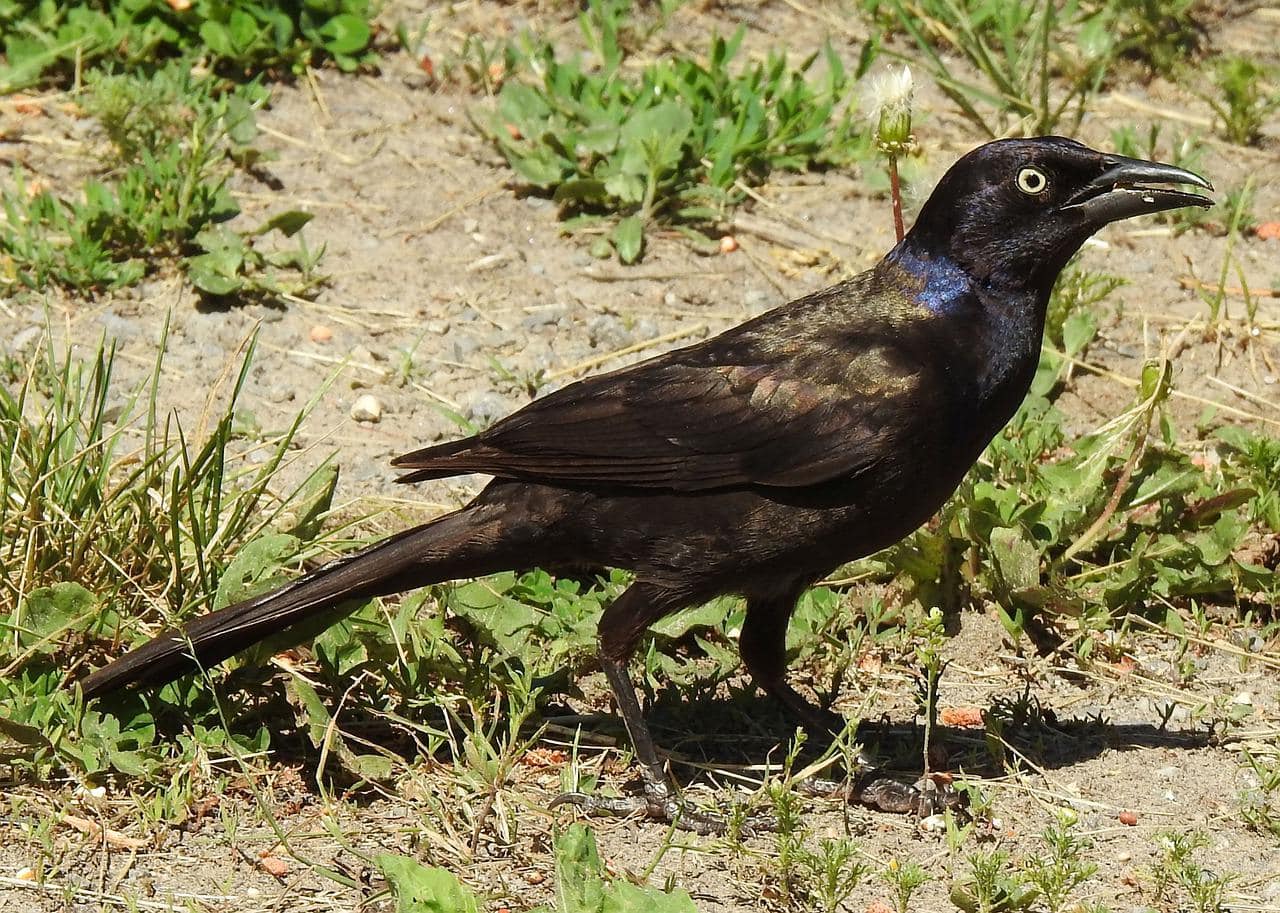
| Scientific name: | Quiscalus quiscula |
| Family: | Icteridae |
| Endangerment: | Unstable |
Common Grackles are not as common as they used to be—their population has decreased significantly, although their numbers are still high. Males exhibit a teal color on their heads, in addition to a multi-colored coat. They’re omnivorous and search the open ground for food. Unfortunately, they’ve been known to go through trash for a meal as well.
13. Gray Catbird
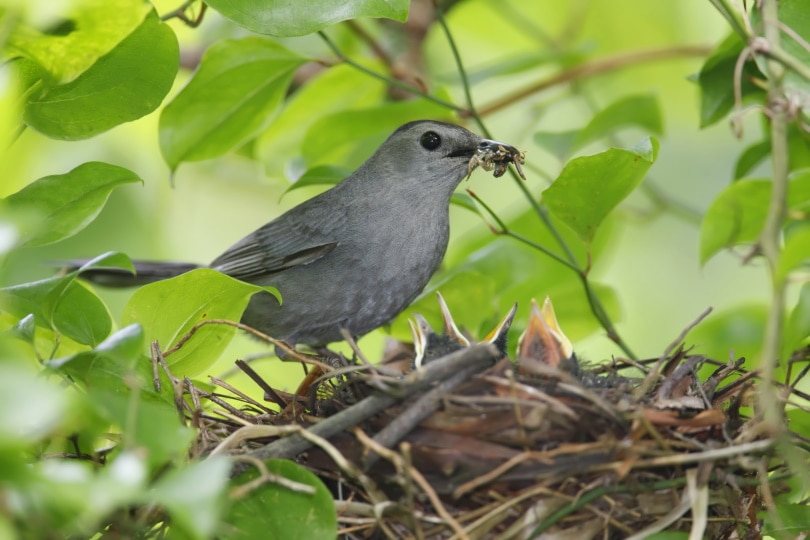
| Scientific name: | Dumetella carolinensis |
| Family: | Mimidae |
| Endangerment: | Stable |
In the east of Maryland, you can view the Gray Catbird year-round. In the western half of Maryland, this species only retains its space for breeding purposes and then migrates south for the cold season. In the open woodlands, they nest in bushes and gather insects from the ground. They mimic the calls of other bird species, which is an ability found more commonly with mockingbirds.
14. Eastern Bluebird
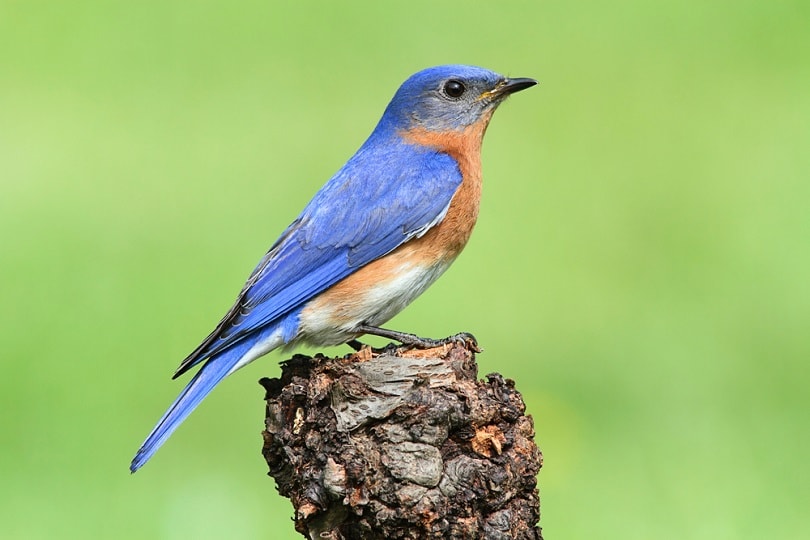
| Scientific name: | Sialia sialis |
| Family: | Turdidae |
| Endangerment: | Stable |
Incredible blue and orange colors are boasted by males to attract mates, and they may not be difficult to see since their habitat consists of wide-open grasslands. In Maryland, the area you will most often see a breeding pair is in the western region. If you do see Eastern Bluebirds here, they will likely be perched on the top of shrubs or small vegetation.
15. Red-Winged Blackbird
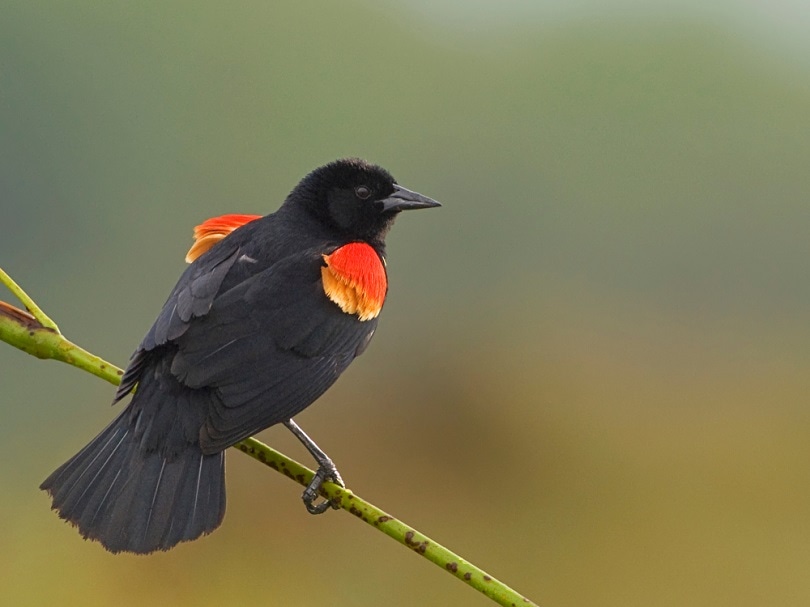
| Scientific name: | Agelaius phoeniceus |
| Family: | Icteridae |
| Endangerment: | Stable |
Red-Winged Blackbirds look completely different depending on their sex. Females have a consistent brown and white pattern with a slightly reddish spot on the top of their wings. However, the males do follow their name more accurately, as they have a black body with deep red, orange, and yellow hues on the base of their wings. They also live in marshlands, so picking out those colors can be straightforward.
16. Tufted Titmouse

| Scientific name: | Baeolophus bicolor |
| Family: | Paridae |
| Endangerment: | Stable |
Tufted Titmice are forest-dwellers that also prefer to eat insects that crawl on tree branches but will also eat your seeds in a feeder if you make it available to them. It’s recommended that you walk on trails or paths to find them since they hang out near the edges of wooded regions. They may bring nuts or hard food items up to the canopy to crack them with their bill.
17. Northern Mockingbird

| Scientific name: | Mimus polyglottos |
| Family: | Mimidae |
| Endangerment: | Stable |
It’s unlikely that you haven’t seen a gray mockingbird in your local area because they flourish in towns and main roads. They eat a variety of foods, such as fish, berries, insects, and seeds. Frequently they can be a nuisance to other birds because they’re highly protective of their boundaries. Northern Mockingbirds can be found state-wide.
18. Osprey
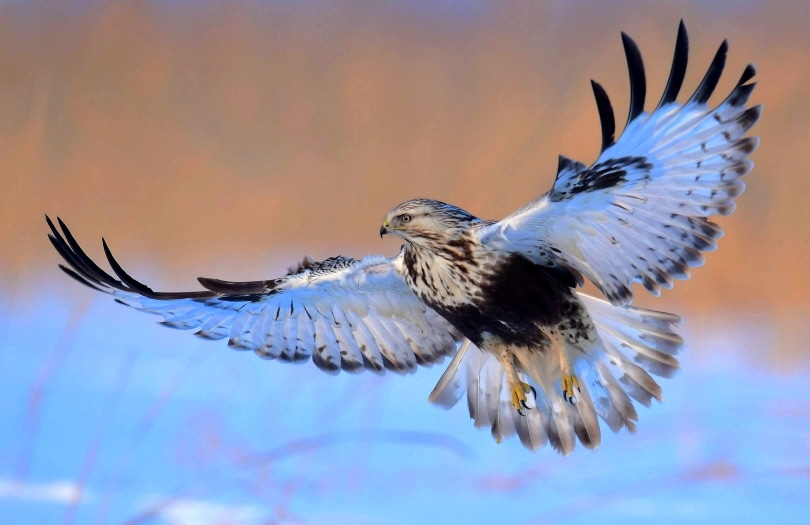
| Scientific name: | Pandion haliaetus |
| Family: | Pandionidae |
| Endangerment: | Stable |
If you live along the coast of Maryland, you’ll have the chance to witness this bird of prey roaming the skies in search of a fishy meal. Their nests are perched high in the trees, with a dense volume of branches and sticks to shield their eggs or babies. It’s an amazing sight to see them dive into the sea with their talons ready to strike.
19. Cooper’s Hawk
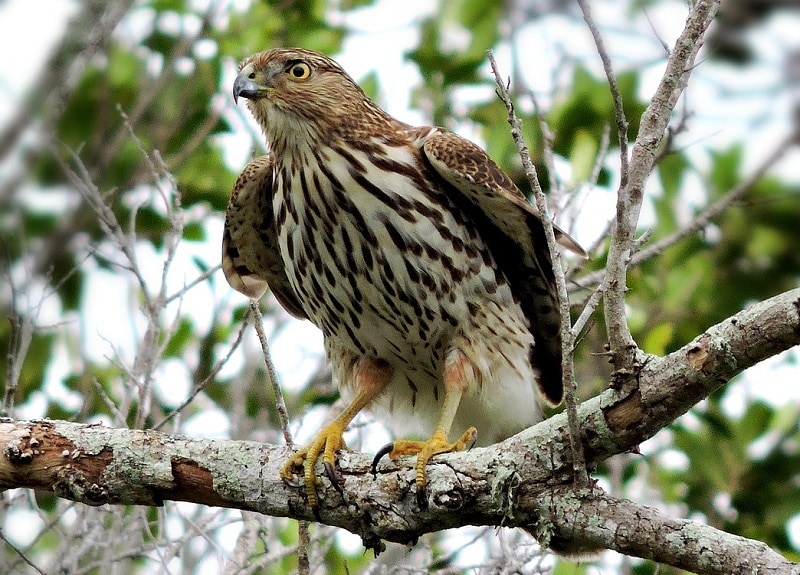
| Scientific name: | Accipiter cooperii |
| Family: | Accipitridae |
| Endangerment: | Stable |
Cooper’s Hawks are large, determined carnivores that hunt rodents and smaller birds. That’s why you may want to be cautious when putting your feeder out for too long, as they may swoop in unknowingly to grasp them for dinner. They can be found in urban areas, too, but they mostly stick to the forests as their main territory.
20. Mourning Dove
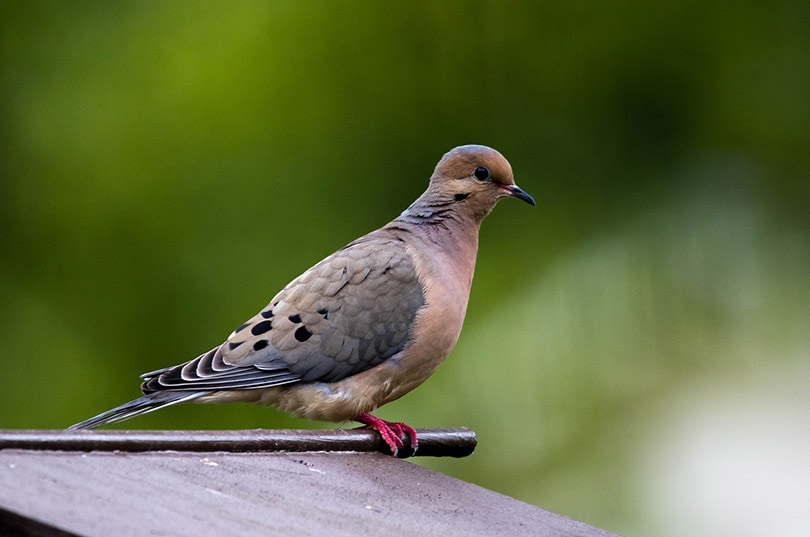
| Scientific name: | Zenaida macroura |
| Family: | Columbidae |
| Endangerment: | Stable |
The recognizable songs of the Mourning Dove are heard throughout the country, where they often perch on telephone wires or branches. They primarily eat seeds on the woodland floors and nest in bushes and trees for protection. Their population is safe. However, they are hunted at an abundant rate across the nation.
21. Song Sparrow
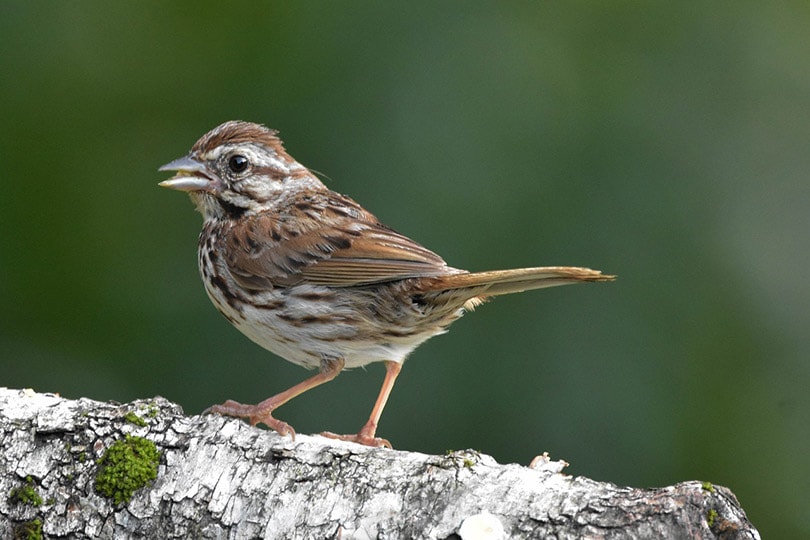
| Scientific name: | Melospiza melodia |
| Family: | Passerellidae |
| Endangerment: | Stable |
The color pattern of Song Sparrows may vary depending on its location, but Maryland’s eastern dominion holds a brown, white, and reddish-toned version. They eat bugs on woodland floors and nest in low-lying shrubs. Males may perch with confidence in open spaces to communicate with other birds nearby.
22. Great-Horned Owl
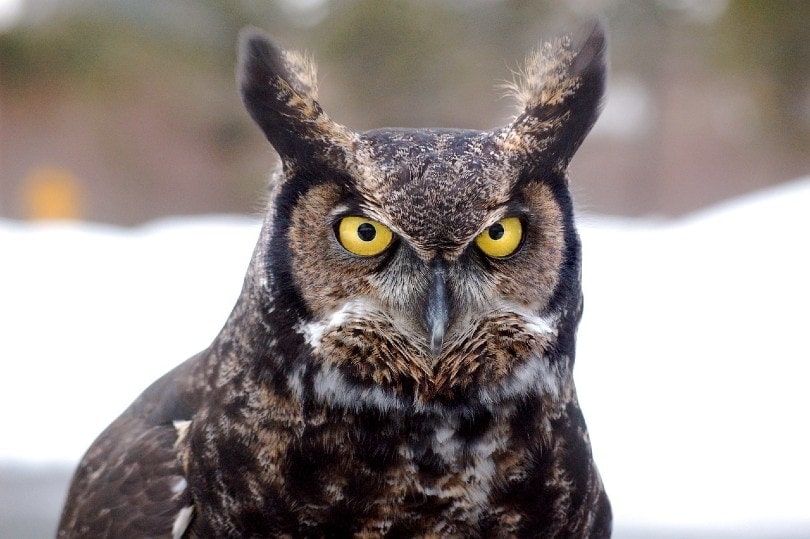
| Scientific name: | Bubo virginianus |
| Family: | Strigidae |
| Endangerment: | Stable |
Owls are amazingly elusive because they’re a nocturnal predator that watches over the forests. At night, they hunt their prey while moving their head in a circular motion to search for dinner. Mice, rats, squirrels, and other rodents are their favorite meal, but they may settle for other small animals if successful. You’ll be able to hear the Great-Horned Owl’s famous “hoot” during the night.
23. Red-Tailed Hawk
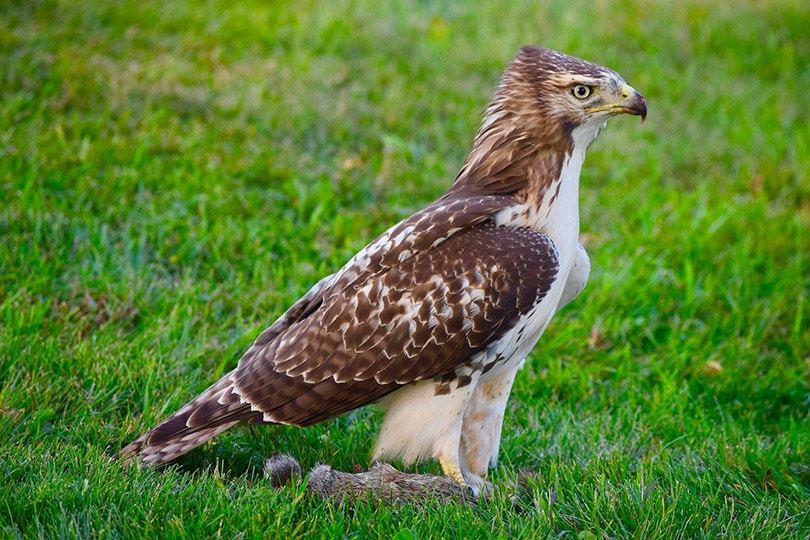
| Scientific name: | Buteo jamaicensis |
| Family: | Accipitridae |
| Endangerment: | Stable |
Red-Tailed Hawks are the most common type of hawk in the country, soaring the skies with their eyes focused below. They search for small animals like frogs, rodents, or smaller critters to eat. You’ll find them in almost any location, especially near rivers or fishing spots where they can pursue their prey. Their nests are fairly large and are built on treetops or telephone poles with a mixture of branches and debris.
24. Dark-Eyed Junco

| Scientific name: | Junco hyemalis |
| Family: | Passerellidae |
| Endangerment: | Stable |
Depending on where a Dark-Eyed Junco is located, there are variations in how these birds look. In the eastern US, Maryland residents will see the grayish-colored Junco with a black hood, whereas, in the western US, they have an orange body with a black hood. Unlike other birds on this list, this species nests on the forest floor, where it also forages for seeds.
25. Ruby-Throated Hummingbird

| Scientific name: | Archilochus colubris |
| Family: | Trochilidae |
| Endangerment: | Stable |
Ruby-Throated Hummingbirds are some of the few red birds in Maryland and naturally have vibrant green and red colors on their body and neck area. If you want to attract them to your backyard, it’s best to use a special feeder that liquid can be poured into. Sugar water will work, or you can find specific hummingbird nectars for sale. Either way, hummingbirds have extraordinarily fast wings and can hover effortlessly. You’ll be able to see them in Maryland during their breeding season in the spring and summer months.
26. Indigo Bunting

| Scientific name: | Passerina cyanea |
| Family: | Cardinalidae |
| Endangerment: | Stable |
As mentioned with the Ruby-Throated Hummingbird, the Indigo Bunting is found in this state only during their breeding season. If you do manage to find them, they have brilliant blue feathers and a happy song. To go along with their majestic tones, they’ve garnered the nickname the “blue canary.” They are fond of insects and scrape leaves for bugs in forest canopies.
27. Chipping Sparrow
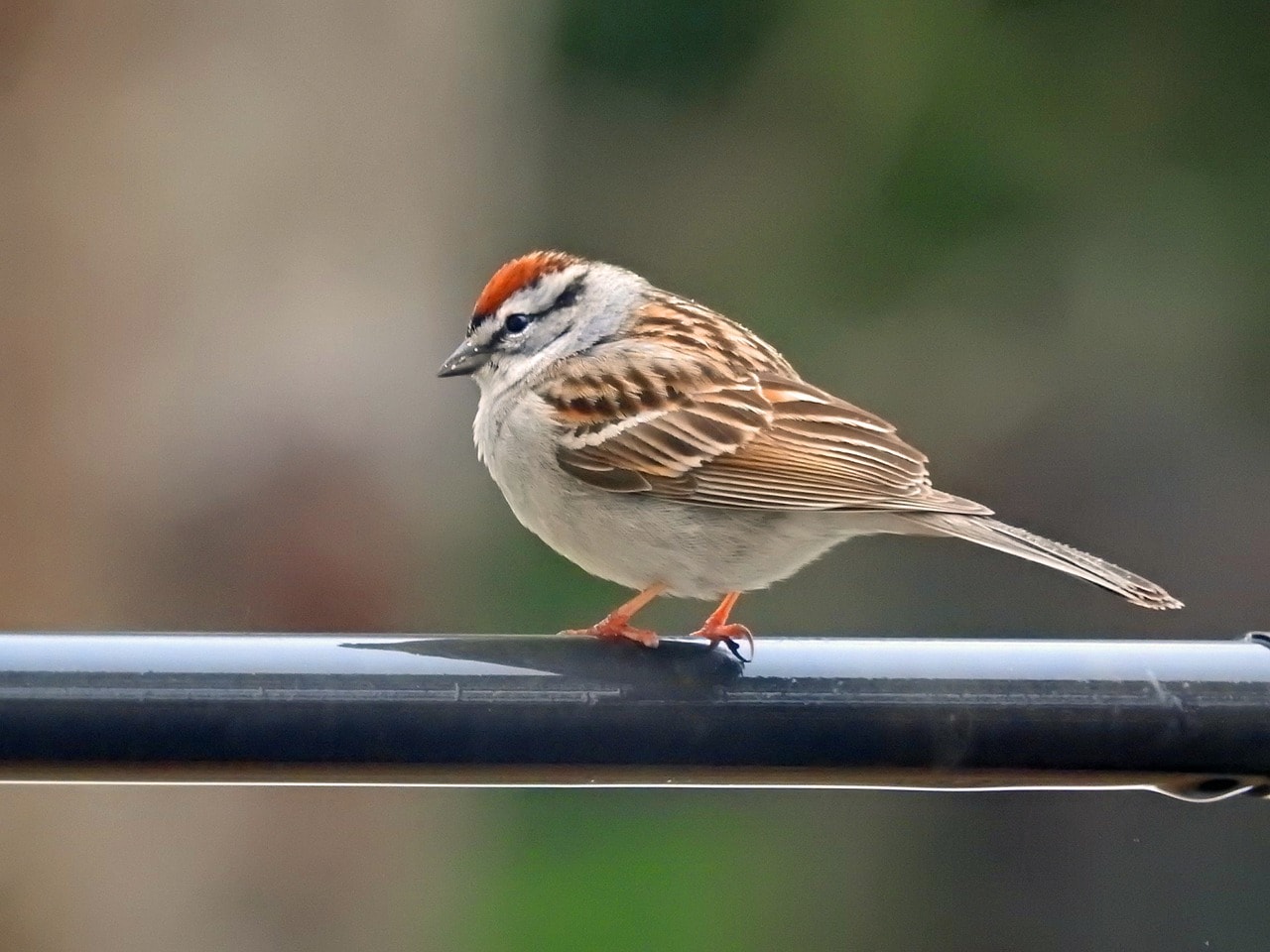
| Scientific name: | Spizella passerina |
| Family: | Passerellidae |
| Endangerment: | Stable |
This species of Sparrow is one that migrates to the central region of the United States but stays in almost the entire nation while breeding. They may live in towns or in the woods and have a quick, constant song that can be heard from afar. The Chipping Sparrow primarily feeds on seeds on the ground.
28. Carolina Wren

| Scientific name: | Thryothorus ludovicianus |
| Family: | Troglodytidae |
| Endangerment: | Stable |
This year-round species can be found anywhere in Maryland, although the name suggests it originates from the Carolinas. Carolina Wrens are commonplace in the east and will even visit your feeder during the winter if you accommodate for it, although they do prefer bugs. Similar to a woodpecker, these wrens will live in small holes inside trees to stay warm and tough out the cold.
29. Tundra Swan

| Scientific name: | Thryothorus ludovicianus |
| Family: | Anatidae |
| Endangerment: | Stable |
Swans are known for their picturesque white feathers and long necks. The Tundra Swan is no different, being a large, floating bird that lives among marshes and ponds. For food, they poke their heads under the water’s surface and seek out certain brushes or plants that they can nibble on. Their migration length is what is so impressive, though, as they’re able to stay warm enough all the way up into the Arctic, where they breed.
30. Least Sandpiper

| Scientific name: | Calidris minutilla |
| Family: | Scolopacidae |
| Endangerment: | Stable |
On the shorelines and marshlands of Maryland, you won’t have a problem finding a Least Sandpiper, which is a miniature bird that uses its long legs to stay up on the sand. They love consuming crabs or other creatures that live close to the coast. They nest on the ground and migrate to this state during certain times of the year.
31. Eastern Screech Owl

| Scientific name: | Megascops asio |
| Family: | Strigidae |
| Endangerment: | Stable |
If you hear some odd noises in the distance at night, it could most definitely be an Eastern Screech Owl. They’ve got distinct, pointy ears that jut out to the sides, and their colors blend perfectly into the tree cavities that they call home. As other owls do, these little birds hunt down mammals to eat and do so from dusk to dawn.
32. Black Skimmer

| Scientific name: | Rynchops niger |
| Family: | Laridae |
| Endangerment: | Unstable |
It’s not great to hear that this species’ population is in decline. This coastal critter is one that predominantly stays in South America. However, they come up to some scattered spots along the east coast for mating, and Maryland is luckily one of those few places. They scour the shorelines for fish, so if you can manage to find fishing spots, you may be able to see some during specific times of the day.
33. Rose-Breasted Grosbeak

| Scientific name: | Pheucticus ludovicianus |
| Family: | Cardinalidae |
| Endangerment: | Stable |
The last bird on this list is the Rose-Breasted Grosbeak. This bird has different colorations for males and females. Males have a red, black, and white tone, while the females have a universal brown, yellow and white mix of shades. Only a small region of southern Maryland is home to their migratory territories, whereas the rest of the state is used as mating grounds.

Conclusion
After a huge selection of 33 common backyard birds in Maryland, you can pick out many that you like and take note of which may be available to watch in your area. Fortunately, most of them are plentiful, while others may be a bit rarer. We wish you good luck on your journey to view the coolest bird species, and remember to respect the wildlife to the best of your ability!
See also:
Featured image Credit By Steve Byland, Shutterstock
Table of Contents
- The 33 Most Common Backyard Birds in Maryland
- 1. American Robin
- 2. American Crow
- 3. Black-Capped Chickadee
- 4. Northern Cardinal
- 5. American Goldfinch
- 6. Blue Jay
- 7. Downy Woodpecker
- 8. Baltimore Oriole
- 9. Red-Bellied Woodpecker
- 10. House Finch
- 11. White-Breasted Nuthatch
- 12. Common Grackle
- 13. Gray Catbird
- 14. Eastern Bluebird
- 15. Red-Winged Blackbird
- 16. Tufted Titmouse
- 17. Northern Mockingbird
- 18. Osprey
- 19. Cooper’s Hawk
- 20. Mourning Dove
- 21. Song Sparrow
- 22. Great-Horned Owl
- 23. Red-Tailed Hawk
- 24. Dark-Eyed Junco
- 25. Ruby-Throated Hummingbird
- 26. Indigo Bunting
- 27. Chipping Sparrow
- 28. Carolina Wren
- 29. Tundra Swan
- 30. Least Sandpiper
- 31. Eastern Screech Owl
- 32. Black Skimmer
- 33. Rose-Breasted Grosbeak
- Conclusion
About the Author Robert Sparks
Robert’s obsession with all things optical started early in life, when his optician father would bring home prototypes for Robert to play with. Nowadays, Robert is dedicated to helping others find the right optics for their needs. His hobbies include astronomy, astrophysics, and model building. Originally from Newark, NJ, he resides in Santa Fe, New Mexico, where the nighttime skies are filled with glittering stars.
Related Articles:
Monocular vs Telescope: Differences Explained (With Pictures)
How to Clean a Refractor Telescope: Step-by-Step Guide
How to Clean a Telescope Eyepiece: Step-by-Step Guide
How to Clean a Rifle Scope: 8 Expert Tips
What Is a Monocular Used For? 8 Common Functions
How to Clean a Telescope Mirror: 8 Expert Tips
Brightfield vs Phase Contrast Microscopy: The Differences Explained
SkyCamHD Drone Review: Pros, Cons, FAQ, & Verdict
